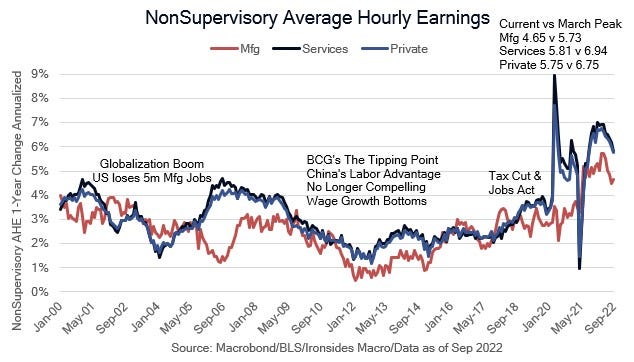Group Think
FOMC group think, meltup risk, inflation outlook, the Price Theory of Labor Equilibrium, the earnings shoe drop
FOMC Group Think
As an anecdotal observation, we do not recall a period where bad economic data is as good for stock prices and vice versa as has been the case since Chairman Powell embraced the DOTs during the September FOMC press conference and sent global markets into an exponential tightening of financial conditions. Ground zero for bad is good is employment data, jobless claims (strong then weak), job openings (weak), the ISM Services Employment Index (strong) and the granddaddy of them all, payrolls, all sparked outsized reactions. Despite overwhelming evidence inflation has peaked, core goods, food, energy, house prices, rents and wages all past peak, there was a steady stream of FOMC participant speeches began with boilerplate ‘stay the course’ inflation language dismissive of the impact of the shock their surprisingly hawkish SEP delivered to the financial (in)stability real interest rate (r**) and the lag effects of monetary policy. We received pushback on our view that the Fed will not implement the SEP forecast for 75bp in November, 50bp in December and 25bp in January because of rapidly tightening financial conditions, improving inflation and a shift in the political climate post midterms, not because investors disagreed with our thesis, instead because investors are taking FOMC participants at their word. We were particularly disturbed by Governor Waller’s speech on Thursday evening, his dismissal of financial stability concerns, uninformed view on the impact of bank reserves on market liquidity and analysis of the housing boom that ignored the impact of policy, instead attributing increased housing demand to pandemic factors (work-from-home). While we are convinced events are going to overtake the FOMC, Friday’s employment report that showed decent demand, mixed supply and softer wage growth was not sufficiently weak to sway the FOMC from their hawkish, and dangerous, policy rate forecast. In the next section of our note, we explain how extreme investor positioning implies that the risk of a melt up is significantly greater than a crash. Positioning is a necessary, but not sufficient condition for a risk-on rally. Data that is so compelling that it overcomes the group think within the Federal Reserve System is the sufficient condition, only CPI and the Employment Cost Index have that potential prior to the next meeting. Markets are screaming the Fed is making another mistake, but the group is tone deaf to the music of the markets.





